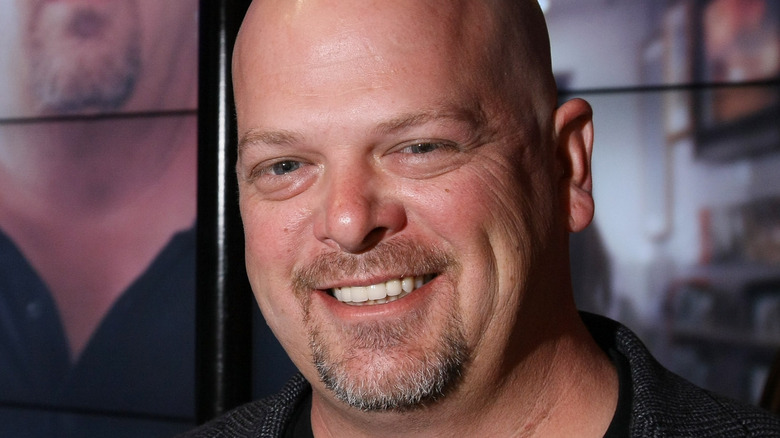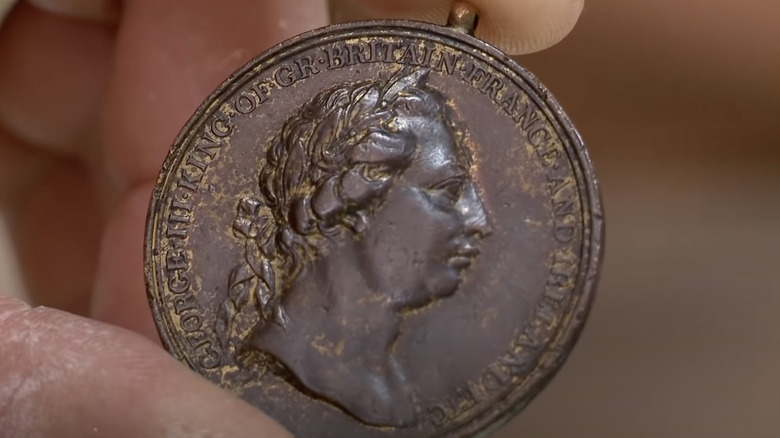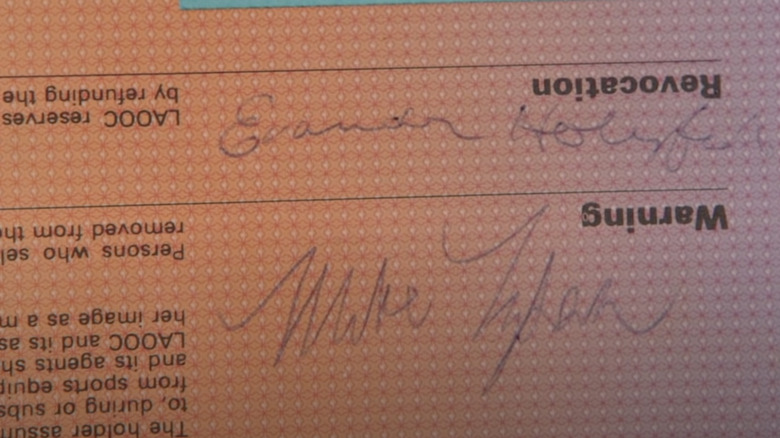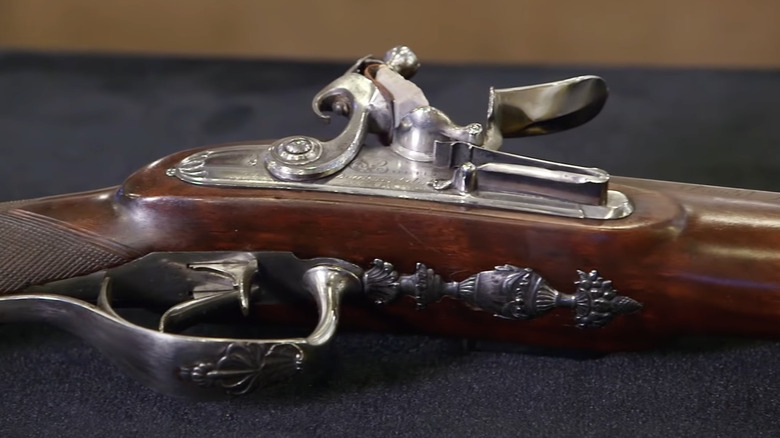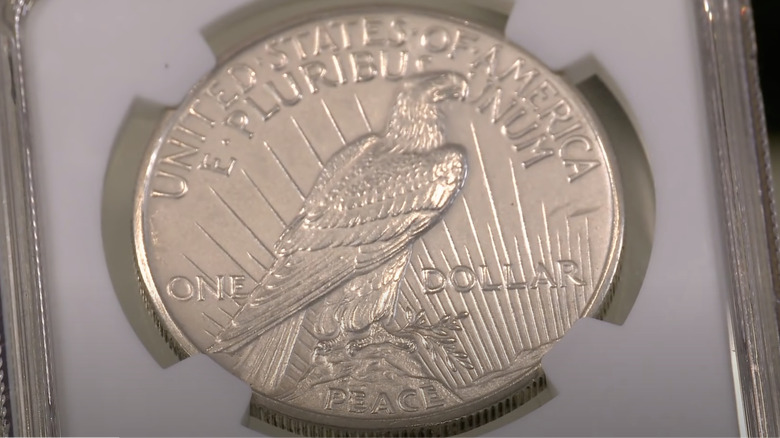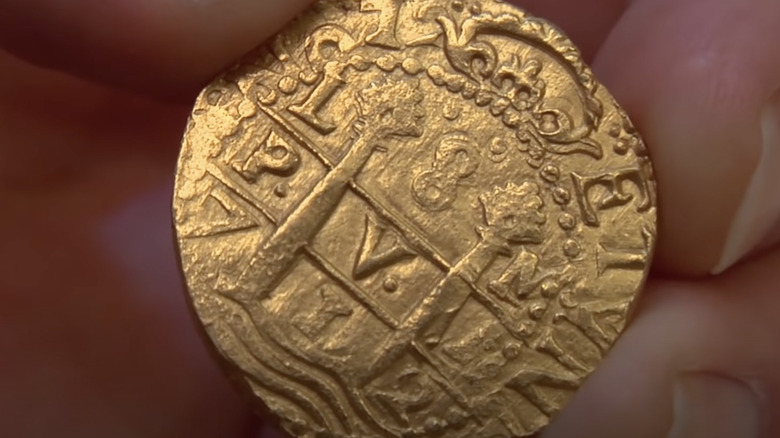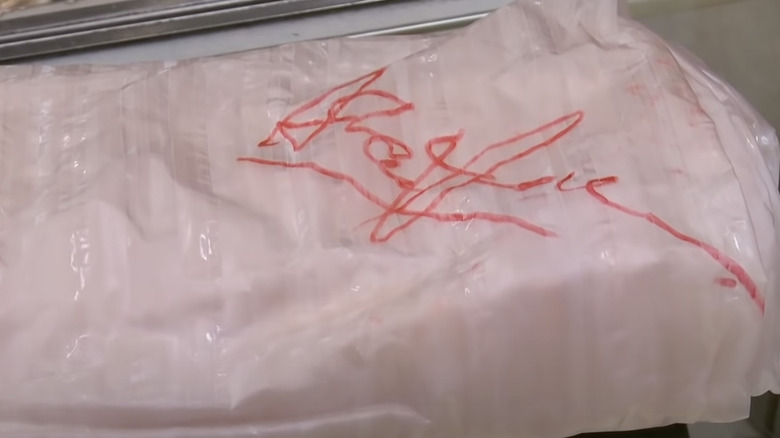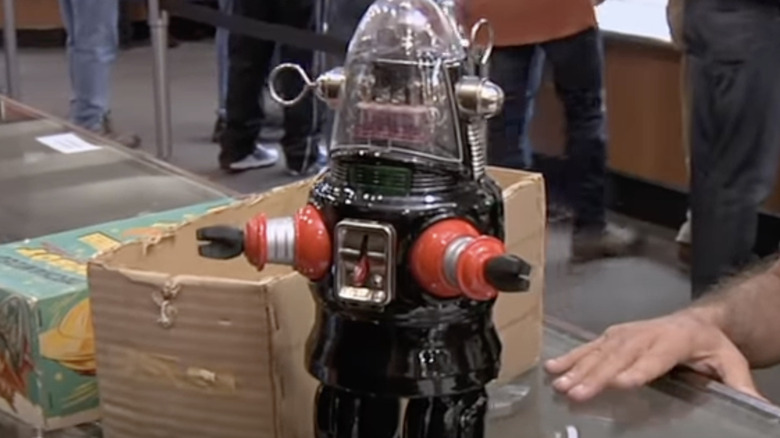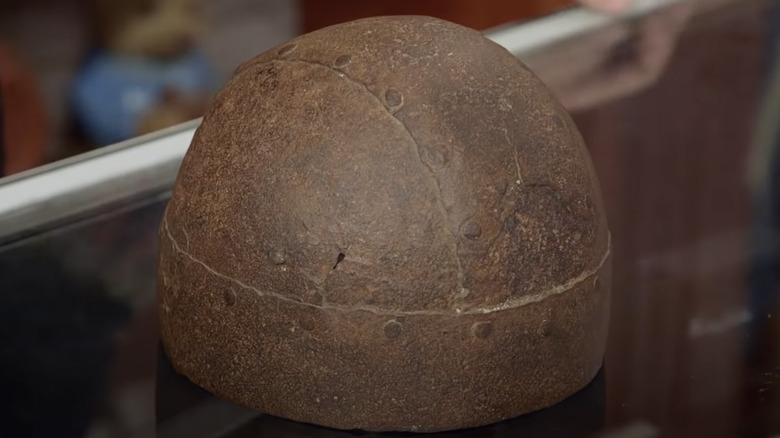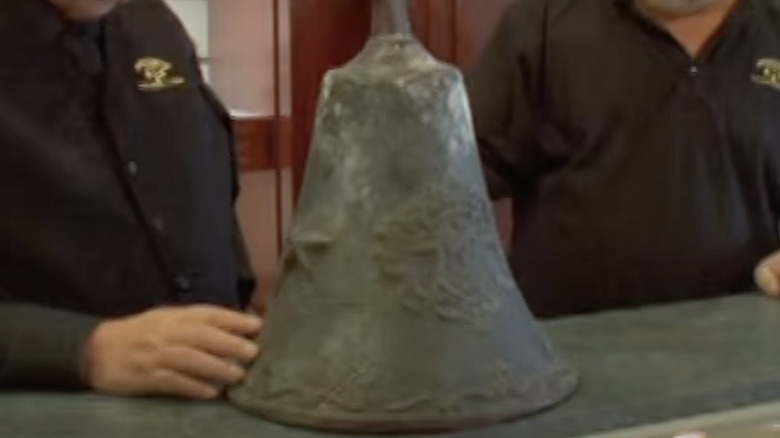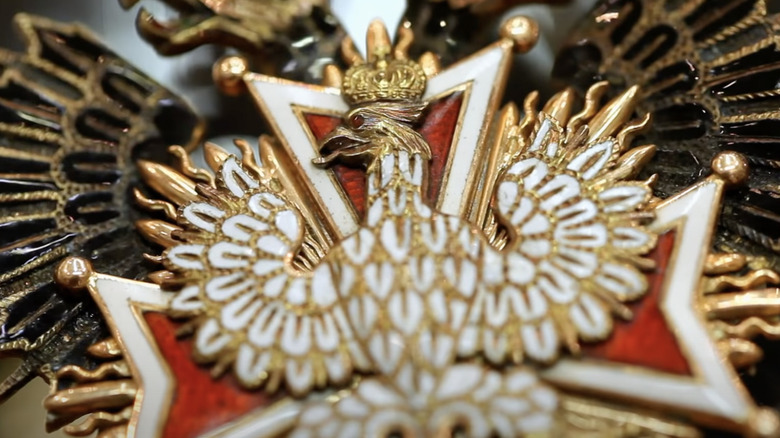Times The Pawn Stars Should Not Have Called In An Expert
"Pawn Stars," airing on History since 2009, is among cable's most successful reality shows, generating hundreds of hours of entertainment from an unlikely source: people trading items for cash at the Gold and Silver Pawn Shop in Las Vegas, Nevada, run by Rick Harrison, Corey Harrison, and the late "Old Man," Richard Harrison. With great regularity, one of the Harrisons (or Austin Lee "Chumlee" Russell) will find themselves flummoxed by an item a customer is offering for sale, and, not knowing how much to propose to pay for it, they'll call in an expert in specific disciplines of collectibles to get a more accurate measure of its worth. Usually, the expert on baseball cards, antiques, stamps, musical instruments, or the like is the bearer of bad news, gently explaining that the item isn't worth nearly what the customer hoped to get in exchange for it.
Once in a while, however, the expert's estimation will greatly exceed the hopes of the client, turning in an appraisal that forces the Harrisons to pay way more for the item than they'd initially intended. Here are the times when one of the "Pawn Stars" could've gotten a steal of a deal if only they hadn't called in one of their experts.
For the medal handled by Captain Cook
In the Season 10 "Pawn Stars" episode "Captain Rick," a man named Jeff entered Gold and Silver Pawn Shop bearing a "really old and hopefully really expensive coin" he found while cleaning out his grandmother's house. Not quite an ordinary piece of currency, the brassy medallion had a metal loop attached and bore the image of King George III of England, the message "sailed from England 1772" with pictures of "Resolution" and "Adventure" on the reverse.
Rick Harrison identifies those as the ships of famed 18th-century explorer and navigator Captain James Cook, who sailed out of England and was one of the first Europeans to set foot in Hawaii and other Pacific islands. Unsure if the piece was actually struck in 1772 or a cheap replica made for gift shops, Harrison calls in David Vagi of NGC Ancients, a local coin expert. Vagi identities the item as being of historical significance. Cook was given 2,000 of these coins, and he was supposed to pass them out to local leaders he encountered in his travels as a "token of esteem." Jeff's coin was held and distributed by Captain Cook himself, and Vagi estimated its value at auction at somewhere between $7,500 and $8,500.
Before he came into the shop, Jeff thought he might get a sum in the hundreds, only to accept Harrison's offer and walk out $5,000 richer.
For the ticket signed by Evander Holyfield and Mike Tyson
Evander Holyfield and Mike Tyson are two of the most famous boxers of all time. In 1984, they were both young amateurs just barely getting their careers going when they found themselves in Los Angeles to participate in boxing events at the 1984 Summer Olympics. Holyfield was competing for the U.S. as a light heavyweight, while Tyson was an alternate. The latter was a little despondent, and so a boxing super-fan and highly involved team USA supporter named Bill, as he'd relate on an episode of "Pawn Stars," took Tyson out to lunch one day in 1984. Bill got Tyson to sign his ticket stub from one of the Olympic matches and then had Holyfield sign it, too.
When Bill presents the double-autographed relic at the Gold and Silver Pawn Shop, he wants $500 for it. Corey Harrison thinks that might be a little, so he calls in Steve Grad, the principal authenticator at Beckett Authentication Services, to verify the item. After analyzing the ink and comparing it to other old Tyson and Holyfield autographs, Grad declares the stub a "winner" and pinpoints its value at around $2,000. Harrison offers Bill $1,000 for the item, but the customer holds firm at $1,500. The two guys reach an impasse, and Bill walks away, deciding to frame the ticket and hang it on a wall instead of selling it.
For a 200-year-old firearm
In a 2020 episode of "Pawn Stars," a man named Dennis was looking to sell off a very old, very well preserved long gun, one that took three different handlers to get a handle on its true worth (of which Dennis seemed already keenly aware). Corey Harrison identified the firearm as being of French origin and something unique, so for a second opinion, he called in his father, Rick Harrison, a lover of historical relics, who immediately realized they had a Boutet rifle on their hands. "He was like a Rembrandt of guns," the elder Harrison said of Nicolas-Noel Boutet, the official gunsmith of King Louis XVI of France and post-revolutionary conqueror Napoleon, who "was like the first one to really combine" function and artistry and catered to very wealthy customers in the late 1700s and early 1800s.
Dennis wanted $10,000 for his treasure, but before offering any amount, the Harrisons brought in Alex Cranmer, CEO of International Military Antiques, to assess the value. A visibly excited Cranmer said "Holy moly!" when he first laid eyes on the piece, and after admiring its detail and ornamentation (and giving it a try on a shooting range), he estimated its potential auction selling price at $30,000. Dennis upped his asking price to $20,000, and Rick Harrison talked him down to $16,000, far above the ten grand the customer first offered.
For a century-old coin
In a Season 10 episode of "Pawn Stars," a guy named John entered Gold and Silver Pawn looking to sell off an item that held little sentimental value but which he felt packed significant financial worth. In an unlikely way, he acquired the encased, 1922-stamped silver dollar "peace emblem" coin, winning it in a poker game. Acting on a hunch that it might be significantly valuable, John wanted $20,000 for his coin, which a giddy Rick Harrison immediately assured him was worth far more, declaring the piece "one of the holy grails of American coins."
The coin was struck in 1921, part of a campaign to bring back the silver dollar to prominent circulation. This coin, something of a prototype, has extra high relief, matte finish, and tremendous detail and was so hard to produce in large quantities that the design was altered in 1922, according to Harrison's coin expert, David Vagi of NGC Ancients. Most of the original run never circulated and was apparently melted down, leaving just a few in existence a century later. Vagi noted that a coin in slightly better shape had recently sold for more than $100,000, and he estimated the value of John's coin at somewhere between $50,000 and $100,000. After some haggling, it pained Harrison to buy the coin off John for $80,000.
For a Spanish coin from the 1700s
As he explains on a Season Two episode of "Pawn Stars," a man named Jody inherited some personal effects from his late grandfather, including a safe bearing little of value besides a gold coin bearing the royal crest of Spain. According to Rick Harrison, Jody's coin is a 1715 Spanish Fleet Coin, specifically a "Lima Escudo," minted in Peru from gold mined by enslaved people during imperial Spain's colonial occupation of South America. The piece is hardly uniform, as things like purity and weight of the gold were far more important — Harrison weighs the coin and finds it consists of 27 grams of pure gold and declares that it's in "exceptional" condition.
Jody wants $2,000 for the heirloom, but since the market had recently been awash in fake Spanish Fleet pieces, Harrison brings in his Spanish colonial coin expert, a guy named Carl. If real, the coin was likely part of King Philip V's personal stash, and Carl's analysis finds it to be "absolutely genuine" and worth around $18,000. After some negotiation, Jody persuades Harrison to pay him $11,000 for it.
For a prop from Psycho signed by its star
Probably the most famous part of "Psycho," Alfred Hitchcock's classic and influential 1960 horror movie, is the scene in which a criminal on the lam played by Janet Leigh is brutally murdered in a motel shower by the disturbed Norman Bates, portrayed by Anthony Perkins. The production certainly went through a few bathroom-related props, like shower curtains, and a plastic one that looked like it could have been used in "Psycho" found its way into the Gold and Silver Pawn Shop on a Season 13 episode of "Pawn Stars." A man named Mark explained that he won it in a contest in San Diego and got it autographed by Perkins after he gave a lecture about directing "Psycho III" in 1986. Mark would ideally want $400 to part with the curtain (signed by Perkins in blood-like red ink) but won't go any lower than $300.
Those terms seem reasonable to Rick Harrison, but to confirm its value, he calls in authenticator Steve Grad. The expert confirms with "no question" that the "awesome" item was indeed signed by Perkins. He puts its value in the area of $800 to $1,000, more than double Mark's asking price. Harrison agrees to buy it for $500.
For a kitschy toy robot
Robby the Robot became one of the most familiar and iconic mechanical men in all of pop culture after its first appearance in the 1956 sci-fi movie "Forbidden Planet." Designed in 1955 for MGM by artist Robert Kinoshita, Robby would eventually appear in more than two dozen movies and TV shows, not counting his appearance in toy form in a Season Five episode of "Pawn Stars."
A client named Stanley pops into the Gold and Silver Pawn Shop bearing a Robby the Robot toy from the mid-20th century, still in its original box. As Stanley explains to a skeptical Corey Harrison and Chumlee, the toy, which he procured a few years earlier at an estate sale, is labeled "Mechanized Robot" and was produced in Japan in the likeness of Robby because MGM wouldn't license out the rights to make name-brand replicas.
Stanley wants $2,000 for the toy and box, but before a deal can be made, Harrison brings in Johnny, an expert on old toys and owner of the Toy Shack. Johnny likes what he sees — the robot still works, and its battery compartment doesn't show any signs of corrosion. Citing the big secondary market for such nostalgic toys, Johnny figures the robot's value at $2,200, more than Stanley's dream price. After some countering, Harrison buys the toy for $1,100.
For an ancient Anglo-Saxon helmet
A young man named Kevin headed into the Gold and Silver Pawn Shop on a Season 17 episode of "Pawn Stars" to inquire about selling a helmet he bought at an estate sale. The former football player thought the item was reminiscent of a simple helmet from the sport's early days, but after some research, found out that it's probably an iron battle helmet from the Anglo-Saxon era of European history, and Chumlee agrees that the metal cone (used to defend against direct arrow hits) could be up to 1,400 years old. I
It's actually a "Spangenhelm," German for "metal strip helmet" because that's exactly what it is, made from thin iron and weighing no more than a relatively light eight pounds. Kevin hopes to get $750 for the piece, but Chumlee has no idea what's worth, so he brings in Bob Dodge of Artemis Testing Lab. Noting how it's remarkable the thing lasted for more than a millennium without oxidizing into dust, Dodge uses an x-ray gun to determine that it's made from carbon steel, thus dating it to Anglo-Saxon times. He suggests the "one in a million" item belongs in a museum and that it's worth about $15,000. Chumlee and Kevin ultimately agree to an $10,000 transaction.
For a bell from a 17th century ship
A woman seeking to cash in an old relic for money she plans to use for moving expenses and a big-screen TV seemed to know she had something pretty valuable when she visited the Gold and Silver Pawn Shop in a 2010 episode of "Pawn Stars." She presents her "1602 shipwreck Dutch East India Company Bell" to Rick Harrison and his father, the "Old Man," the latter of whom is instantly skeptical that the item is of much value or even went through a shipwreck. Ironically, it's in too good shape — the elder Harrison doesn't think it bears enough corrosion to have been in salt water for any lengthy period of time.
It would have been good for business had the Harrisons made a nominal offer for the bell, a relic of the Dutch East India Company's 1600s-1800 domination of world trade, because the expert they called in to evaluate the bell generated a high price for the item. He explained that the bell likely could have been involved in a shipwreck because the lack of damage indicated that it could have been present in the 90 percent of shipwrecks that occur in shallow water. Citing its authenticity and worthiness of being in a treasure auction catalog, the expert cited a cash value of $15,000.
For a European war medallion
While the House of Fabergé, famous for its Fabergé eggs, was the most prestigious jewelry in imperial Russia of the 1800s, its main competitor was the equally impressive House of Bolin. According to Craig Gottlieb, of Craig Gottlieb Military Antiques, that is who manufactured a medal that came across the display cases at the Gold and Silver Pawn Shop in a 2014 episode of "Pawn Stars."
Rick Harrison thinks he's offered a substantial sum of $6,000 to the client who brought in the piece; a "White Eagle Medallion" thought to be a centuries-old, gem-studded Polish piece. Gottlieb explains it's not really Polish, but Russian. In 1795, Poland was partitioned into segments ruled by Prussia, Austria, and Russia, and the latter took a symbol of a Polish order founded in 1325, a white eagle, and combined with an imperialist Russian symbol — a two-headed eagle. The medallion, with both images present, tells the story of Russia conquering Poland. Gottlieb says the medallion was likely forged in St. Petersburg and that it's worth $30,000 to $40,000, putting Harrison on the hook for a much larger sum than initially offered.
